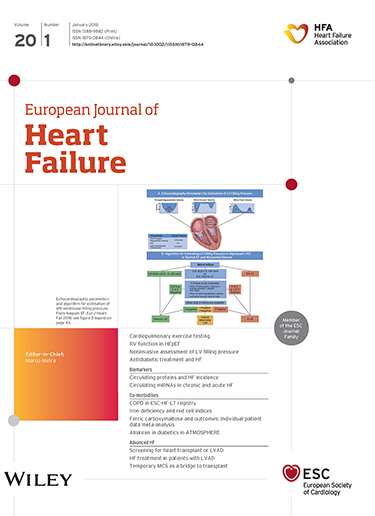Peroxiredoxin-4, a marker of systemic oxidative stress, is associated with incident heart failure
Abstract
Aims
Oxidative stress is known to be involved in the pathophysiology of heart failure (HF). To assess oxidative stress, direct quantification of reactive oxygen species would be ideal but this is not feasible due to their short half-lives. Antioxidant enzymes such as peroxiredoxins, produced as a direct response to oxidative stress, mirror the process and can be more easily quantified. The aim of this study was to examine whether circulating peroxiredoxin-4 (Prx4), a marker of systemic oxidative stress, associates with incident HF and its subtypes.
Methods and results
We included a total of 8199 individuals from the Prevention of REnal and Vascular End-stage Disease (PREVEND) community-based cohort (mean age: 49.8 years; 50.1% women). During a median follow-up of 12.6 years, 349 (4.3%) HF events occurred of which 118 (33.8%) had HF with preserved ejection fraction. In a Cox proportional hazards model adjusting for age, sex, smoking, diabetes, hypertension, obesity, total and high-density lipoprotein cholesterol, cholesterol-lowering medication and renal disease, Prx4 was significantly associated with incident HF (hazard ratio [HR] per 1 standard deviation increase in log-Prx4: 1.22; 95% confidence interval [CI] 1.09–1.36; p < 0.001). Among HF subtypes, Prx4 remained associated with incident HF with preserved (HR 1.27; 95% CI 1.05–1.53) as well as reduced ejection fraction (HR 1.19; 95% CI 1.04–1.37), with no significant difference between the subtypes (p = 0.64).
Conclusion
Circulating Prx4 associates with the risk of developing HF, both with preserved and reduced ejection fraction. Future studies should examine whether Prx4 can serve as a real-time marker of oxidative stress status.

 求助内容:
求助内容: 应助结果提醒方式:
应助结果提醒方式:


